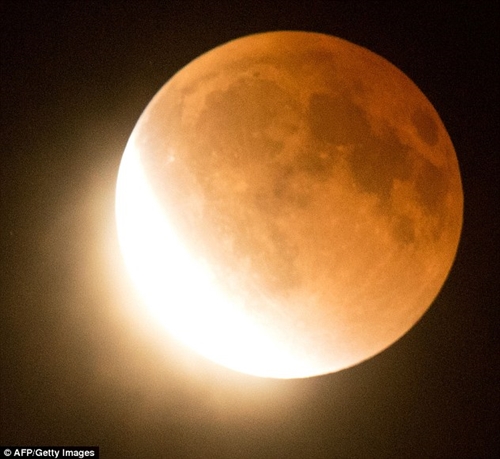
File photo (Image: AFP/Getty)
Skygazers can enjoy the longest lunar eclipse of the 21st century next month.
The lunar event, which takes place on July 27, will be visible to most people living in the Eastern hemisphere and will last for 103 minutes - four minutes short of the longest possible duration an eclipse could last.
The rare celestial event is the result of several astronomical events aligning, which will prolong the phenomenon.
During the eclipse, the moon will pass through Earth's darkest shadow, known as umbra, causing it to take on a red sheen, giving rise to the 'blood moon' name.
No equipment is needed to view the event, with the naked eye more than enough to watch the century's most impressive eclipse.

Unlike a solar eclipse, where the moon crosses the path of the sun, it is perfectly safe to look directly at the lunar eclipse.
People hoping to enjoy the 'blood moon' need only to hope for clear skies.
The total eclipse is set to last for 1 hour 43 minutes, but a partial eclipse will be visible for almost four hours.
The total eclipse begins at 7:30 pm UTC (8:30 BST), and ends at 9:13 pm UTC (10:13 BST). The peak of the eclipse will occur at 8:22 pm UTC (9:22 BST).
Mathematically, the longest an eclipse could ever last is 1 hour 47 minutes, and the longest eclipse of the 20th Century (1901-2000) happened on July 16, 2000. This period of total eclipse lasted for 1 hour 46.4 minutes.
Only those in the Eastern Hemisphere will be able to view the upcoming event, with people in Europe, Africa and Asia getting the best seats for the lunar show.
Skygazers in South America will be able to see part of the final stages of the eclipse just after sunset on July 27.
In contrast, New Zealanders will be able to watch the start of the eclipse before sunrise July 28. It will not be visible at all in the United States.
Parts of central Asia, the Middle East and Eastern Africa will see the lunar eclipse in its entirety.
The UK falls slightly outside of the ideal viewing range, meaning people will see the total eclipse for only 84 of the 103 total minutes. This is due to the moon being below the horizon in Britain when the eclipse begins.
To get the best view of the eclipse, make sure you are in an area with low-light pollution. For example, high vantage points in a built-up area, or ideally, a trip to the countryside should provide the best view.
Those who want to photograph the lunar transit will be able to do so with a bit of patience, a telescope and the right app. Both Android and iOS have apps available to help capture a picture of the event.
A lunar eclipse occurs when the sun, Earth, and moon fall in line with one another, bringing the moon into line with the shadow cast by the Earth.
When this happens, Earth blocks any sunlight hitting the moon, and casts its own shadow onto its surface as well.
Lunar eclipses can be extended based on the location of the moon in its orbit. For the upcoming eclipse, the moon will also be at its farthest point from Earth, known as apogee.
As a result, the moon will look smaller than usual, and consequently, the time it takes to cross through the shadow cast by the Earth will be longer then usual.
The last notable lunar event was at the start of 2018, when a 'super blood blue moon' graced our skies.
*******
Source: Dailymail UK


Post A Comment:
0 comments: